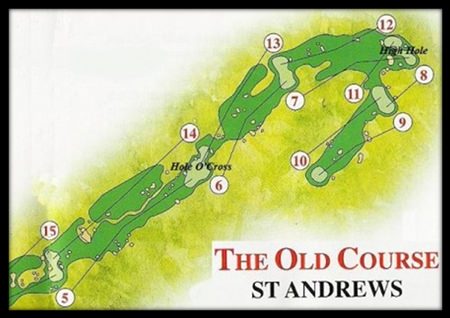Was there something mystical about the number 18? Did it have anything to do with the notion that it took precisely 18 nips to polish off a bottle of scotch? Or was it more to do with Old Tom Morris’s hitherto unknown conversion to Hinduism, where the number 18 has huge significance.
After all it was, according to some, Old Tom who, as Head Greenkeeper at the Old Course, standardised course design from 22 holes down to 18. Alas, this has as much to do with the fact as the 18 tipple version above. More likely, establishing that a round of golf should consist of 18 holes had more to do with an accident of history than any other single reason.
Early golf courses had differing numbers of holes:
- Leith Links: five holes in 1744, expanding to seven a short time later.
- Bruntsfield Links: five holes later expanding to six in 1818.
- Musselburgh: seven holes going to eight in 1832 and nine in 1870.
- Montrose Links: seven holes in 1810, 11 holes by 1849, 25 holes by 1866, and reduced to 18 after 1874.
- St Andrews (Old): 12 holes by 1764 (and probably much earlier) laid out in a line. Ten holes were played twice – once going “out” and once “coming back in” making a round of golf 22 holes.
- Prestwick: built as late as 1851, with just 12 holes.
Around 1764 the golfers at St Andrews combined the first four short holes into two, thus producing a round of 18 holes, though it was still 10 holes of which eight were played twice. This heralded the commencement of the 18-hole round, although it would be another 100 years before there were 18 actual holes.
 Old Course St Andrews – depicting the Hole O’Cross 5th and the High Hole 7th.
Old Course St Andrews – depicting the Hole O’Cross 5th and the High Hole 7th.
By the middle of the 1800s some clubs were playing 18 holes medal, but historians argue that this was purely by accident. Lanark, for example, had six holes that were played three times. When, in 1854 they added another hole, a round consisted of 21 holes.
The R&A Rules of Golf of 1842 (note; there was no such thing as a national golf body), laid down an 18-hole round even though the course was not 18 different holes. Between this time and 1855, the Old Course introduced double-greens such as on the 5th and 7th, but it wasn’t until May 1857 that the true 18-hole course came into being.
According to R&A records, around 1857 one Allan Robertson was paid 20 pounds in respect of work on “double greens”. From this it is assumed that greens were enlarged sufficient to accommodate two holes, played simultaneously, as reported by the Fifeshire Journal of that time.
“The putting greens have had a thorough overhaul, re-turfed and otherwise improved. On each green, with the exception of the first and return, two holes have been placed; the one is played to by parties going outwards, the other in the in-coming. To prevent mistakes, the outgoing hole is supplied with a white flag, and its neighbour sports a red one, that being the colour for all the return holes. This is a decided improvement on the old system, preventing confusion and delays which often had to be put up with , on medal days especially when a party going out encountered another winding their way homewards on the same green, there being only one hole betwixt them.”
Only one hole betwixt them; yes that’s right, for around 100 years and more, golfers coming down the home stretch would be endeavouring to play their ball into the same hole as those playing the outward nine. Imagine the fun to be had in Pattaya if an outgoing IPGC group encountered an incoming PSC group, all aiming for the same hole. Pity the poor course marshal.
No wonder the local press labelled it a decided improvement. Over the next few years other courses followed suit. It appears many prominent members of the R&A were also members elsewhere, although it took a further 25 years before there were 18 golf courses with 18 different holes.
Another possible influencing factor may have been the Open Championship. From 1872 this event was held annually in rotation at Prestwick, St Andrews and Musselburgh. The Championship was played over 36 holes; meaning three rounds at Prestwick, two at St Andrews and four when played at Musselburgh. From this, the St Andrews layout may have seemed the most appropriate.
In 1882, Prestwick expanded to 18 holes. In 1891, when the Honourable Company built Muirfield they created 18 holes from inception. Hosting the Open moved with them from Musselburgh, thus the world’s leading three clubs and the ones that hosted the Open Championship, set the 18-hole benchmark.
Amazingly, the 18-hole round was not laid down as a stipulated round in the Rules of Golf until 1950.
I still prefer the 18-snifter version. Never let facts stand in the way of a good story.
Golfnutter




